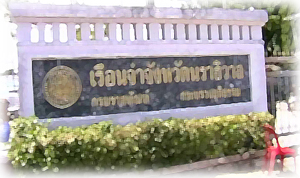A reflection of the Narathiwat provincial prison riot
 This is a personal account of the prisoners’ riot at the Narathiwat provincial prison on August 11-12 of Mr Kamonsak Leewamoh, Narathiwat provincial chairman of the Muslim Lawyers Centre Foundation.
This is a personal account of the prisoners’ riot at the Narathiwat provincial prison on August 11-12 of Mr Kamonsak Leewamoh, Narathiwat provincial chairman of the Muslim Lawyers Centre Foundation.
On the first day of the riot at the Narathiwat provincial prison on August 11, 2011, I was observing the situation from a long distance through the prison’s barricade and through media’s coverage of the event. My feelings then were that pretty soon the authorities would be able to control the situation despite the fact that I didn’t know the actual cause of the riot and the real situation.
My understanding that the situation would return to normal soon because there was a riot at the same prison in June and that it ended peacefully.
However this time, deep in my feelings, I felt concerned with several of my brothers in the prison, especially those whom I used to help defending their cases and many of whom are now getting my legal assistance. I wondered how about them during the riot which coincided with the month of Ramadan (Muslim fasting month).
On the night of August 11, it appeared, according to news report, that the situation in the prison was still not normal. Many questions poured in asking what actually had happened. Personally, I was worried because the situation started to affect my court cases the some of the defendants could not attend the trial.
On the following day, several calls came in asking me to visit the prison on their behalves in unofficial capacity. Other representatives of the government visiting the prison included Pol Col Thawee Sodsong, deputy permanent secretary of justice, and Mr Chartchai Sutthiklom, director-general of Corrections Department.
That morning I felt stressed about the prison’s visit and tried to get more information about the riot from my assistants who had been observing the situation from outside the prison. It appeared that none of them were aware of the real situation. Then I contacted the president of the Muslim Lawyers Centre Foundation for advice and was told to use my judgement.
The stress increased when I arrived at the prison because the situation was very tense. I met with the deputy permanent secretary of justice, the provincial governor, the corrections department chief and several other officials. I was amazed that none of them knew what the prisoners had actually wanted.
Most my worry was that the situation might become more tense because neither the officials nor the prisoners knew about the wishes of either side. So I tried to get contact with the prisoners by whatever means in order to find out what were their actual demand or demands.
The only sensitive part of my effort was that it could be misinterpreted by the authorities that I was siding with the prisoners. Finally, I decided not to bother whether the authorites would become suspicious of me or not and went ahead with contacting the prisoners.
Finally, I got hold of some prisoners and what they told me, to my amazement, was totally different from situation outside the prison. Previously, we thought the prisoners must have many demands or conditions. But it wasn’t the case. The cause of the trouble did not come from prisoners facing security-related charges. On the contrary, they were the ones who tried to keep the situation from spiraling out of control.
I information I received was that the prisoners wanted the situation to return to normal as soon as possible because the prisoners did not have water and electricity as they were completely cut off. That the walls of some prison cells were broke because the prisoners could not stand the heat and they were too afraid to get out of the prison building for fear of attacks from the security forces who were armed and surrounded the prison building.
When I knew about the truth about the situation, I contacted the deputy permanent secretary of justice and the corrections department chief to ease the tension by restoring electricity and water supplies to the prison. I also informed them that the prisons did not have any demands or conditions but only wanted to situation to return to normal and also didn’t want the authorities to resort to violence.
The prisoners asked for time for a cleanup before starting the dialogue with the authorities. At about 3.30 p.m., talks started and eventually it was agreed by both sides that they wanted the situation to return to normal.
In conclusion, the cause of the riot did not concern any specific demand. In fact, it stemmed from the search process of prisoners in the sleeping quarters which went out of control. This should serve a lesson to the authorities to reconsider the search process in order to prevent such an incident from recurring.
But the point that I wanted to make most and that was also my concern was about the attitude of the authorities toward the prisoners facing security-related charges. The fact about this riot was that it was started by prisoners convicted with drug charges and other criminal charges and not by prisoners or detainees facing security-related charges as suspected by the authorities.
As clearly proven in this incident, there remains a huge gap of mustual distrust between the authorities and those facing security-related charges or the militants and their supporters. But the gap can be narrowed if these detainees or prisoners are ensured access to fair justice and they are treated with less bias from the authorities.
----------------------------------------------------------------------------------------------------------------------
Caption : Narathiwat provincial prison
